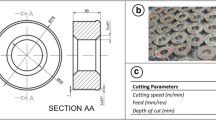Abstract
Vibrations are very prejudicial to machining as they directly affect the dimensional accuracy and surface roughness of the machined part. Excessive vibration must be avoided or at least reduced. This can be achieved in several ways, including the use of dampers and more rigid material for tool holders. Tool vibration is stimulated in internal turning by the cantilever shape of the tool and the large tool overhang used, impairing the quality of the turned part. This is a serious problem in the turning of hardened steel because internal turning is usually the last operation carried out on the surface, making tight tolerances and low surface roughness values necessary. Excessive vibrations would harm the surface finish and could lead to tool breakage because of the low toughness of the tool materials used for this kind of application. The main objective of this work was therefore to identify alternative approaches for finishing internal turning of long holes in hardened steel parts. Different tool holder materials (steel and cemented carbide) and a particle impact damped steel tool holder were tested to determine the longest overhang that could be achieved in each configuration. The results showed that carbide bars reduced vibrations and allowed longer overhangs to be used. Particle impact dampers may be a simple alternative to the more expensive carbide bars.
Similar content being viewed by others
References
Huo D, Cheng K (2009) Basic concepts and theory. In: Cheng K (ed) Machining dynamics: fundamentals, applications and practices. Springer, London, pp 7–20
Rivin EI, Kang H (1992) Enhancement of dynamic stability of cantilever tooling structures. Int J Mach Tools Manuf 32(4):539–561. doi:10.1016/0890-6955(92)90044-H
Sortino M, Totis G, Prosperi F (2012) Development of a practical model for selection of stable tooling system configurations in internal turning. Int J Mach Tools Manuf 6:58–70. doi:10.1016/j.ijmachtools.2012.05.010
Selvam MS (1975) Tool vibration and its influence on surface roughness in turning. Wear 35:149–157. doi:10.1016/0043-1648(75)90149-0
Kiyak M, Kaner B, Sahin I, Aldemir B, Cakir O (2010) The dependence of tool overhang on surface quality and tool wear in the turning process. Int J Adv Manuf Technol 51(5–8):431–438. doi:10.1007/s00170-010-2654-y
Devaraj S, Shivalingappa D, Channankaiah, Jangaler RS (2014) Surface quality enrichment using fine particle impact damper in boring operations. Int J Res Eng Technol 3(2):531–535. eISSN: 2319–1163
Atabey F, Lazoglu I, Altintas Y (2003) Mechanics of boring processes—part I. Int J Mach Tools Manuf 43:463–476. doi:10.1016/S0890-6955(02)00276-6
Quintana G, Ciurana J (2011) Chatter in machining processes: a review. Int J Mach Tools Manuf 51:363–376. doi:10.1016/j.ijmachtools.2011.01.001
Song Q, Shi J, Liu Z, Wan Y, Xia F (2015) Boring bar with constrained layer damper for improving process stability. Int J Adv Manuf Technol. doi:10.1007/s00170-015-7670-5
Siddhpura M, Paurobally R (2012) A review of chatter vibration research in turning. Int J Mach Tools Manuf 61:27–47. doi:10.1016/j.ijmachtools.2012.05.007
Ema S, Marui E (1994) A fundamental study on impact dampers. Int J Mach Tools Manuf 34(407):407–421. doi:10.1016/0890-6955(94)90009-4
Waydande S, Mahajan DA, Gajjal SY (2014) A review on vibration attenuation of boring bar using passive dampers. Int J Emerging Technol Adv Eng 4(4):117–122. ISSN 2250–2459
Rubio L, Loya JA, Miguélez MH, Fernández-Sáez J (2013) Optimization of passive vibration absorbers to reduce chatter in boring. Mech Syst Signal Process 41:691–704. doi:10.1016/j.ymssp.2013.07.019
Vinayaravi R, Kumaresan D, Jayaraj K, Asraff AK, Muthukumar R (2013) Experimental investigation and theoretical modelling of an impact damper. J Sound Vib 332:1324–1334. doi:10.1016/j.jsv.2012.10.032
Zhang C, Chen T, Wang X, Li Y (2014) Discrete element method model and damping performance of bean bag dampers. J Sound Vib 333:6024–6037. doi:10.1016/j.jsv.2014.07.011
Ema S, Marui E (1996) Damping characteristics of an impact damper and its application. Int J Mach Tools Manuf 36(3):293–306. doi:10.1016/0890-6955(95)00073-9
Lu Z, Lu X, Masri SF (2010) Studies of the performance of particle dampers under dynamic loads. J Sound Vib 329:5415–5433. doi:10.1016/j.jsv.2010.06.027
Du Y, Wang S (2010) Modeling the fine particle impact damper. Int J Mech Sci 52:1015–1022. doi:10.1016/j.ijmecsci.2010.04.004
Ema S, Marui E (2000) Suppression of chatter vibration of boring tools using impact dampers. Int J Mach Tools Manuf 40:1141–1156. doi:10.1016/S0890-6955(99)00119-4
Kumar MS, Mohanasundaram KM, Sathishkumar B (2011) A case study on vibration control in boring bar using particle damping. Int J Eng Sci Technol 3(8):177–184. doi:10.4314/ijest.v3i8.15
Lawrance G, Paul PS, Varadarajan AS, Praveen AP, Vasanth XA (2015) Attenuation of vibration in boring tool using spring controlled impact damper. Int J Interact Des Manuf. doi:10.1007/s12008-015-0292-1
Sims ND, Amarasinghe A, Ridgway K (2005) Particle dampers for workpiece chatter mitigation. ASME 2005 Int Mech Eng Congress Exposition. doi:10.1115/IMECE2005-82687
Marhadi KS, Kinra VK (2005) Particle impact damping: effect of mass ratio, material, and shape. J Sound Vib 283:433–448. doi:10.1016/j.jsv.2004.04.013
Hessainia Z, Belbah A, Yallese MA, Mabrouki T, Rigal J (2013) On the prediction of surface roughness in the hard turning based on cutting parameters and tool vibrations. Measurements 46:1671–1681. doi:10.1016/j.measurement.2012.12.016
Coromant S (2009) Technical guide. Sandvik, Sandviken
Author information
Authors and Affiliations
Corresponding author
Rights and permissions
About this article
Cite this article
Suyama, D.I., Diniz, A.E. & Pederiva, R. The use of carbide and particle-damped bars to increase tool overhang in the internal turning of hardened steel. Int J Adv Manuf Technol 86, 2083–2092 (2016). https://doi.org/10.1007/s00170-015-8328-z
Received:
Accepted:
Published:
Issue Date:
DOI: https://doi.org/10.1007/s00170-015-8328-z



